 Written by Mike Price, OT
Written by Mike Price, OT
When mobility challenges make independently moving between a chair, bed, wheelchair, or toilet difficult or even impossible to accomplish safely, a transfer aid makes going from one place to another safer and more comfortable for a patient and caregiver.
Moving a patient is a common task for a caregiver, and it’s also one of the most physically demanding of duties. Nursing assistants lose work days due to musculoskeletal injuries at five times the rate of other industries. Assistive patient transport devices protect the caregiver from overexertion injuries that can arise from improper or too much heavy lifting while keeping the patient safe during transfer.
There is a wide range of choices to address the unique needs of patients, and the best option depends on the level of mobility, weight-bearing ability, and upper body strength. Our list highlights the top options available in patient transfer devices. No matter what type of assistance is most appropriate, patients and caregivers can count on these products to safely and comfortably move patients from one place to another.
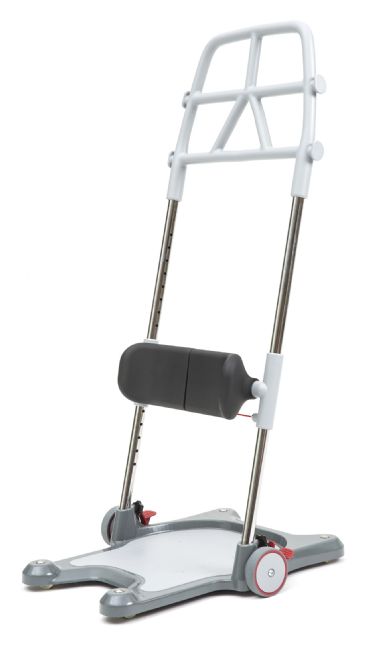 | 1) Molift Raiser Pro Sit-to-Stand Patient Lift View Product |
The two basic kinds of patient lifts are stand-up lifts and sling lifts.
A stand-up lift is designed for patients who have some mobility but need assistance getting up from one seat and transferring to another seat. To safely utilize a stand-up lift, a patient must be able to physically participate in the transfer process. First, the patient needs to be able to sit forward in a chair or sit unsupported on a bed while a caregiver is positioning the sling. For the actual transfer, the patient needs to have enough upper body strength to hold onto the grip handles and be able to bear weight while keeping both feet flat on the footplate while transferring.
Sling lifts are for patients who are disabled or weakened from illness or injury. They are especially useful in transferring heavier patients, lifting them without putting physical strain on a caregiver. Also, these portable patient lifts are easily managed by one person providing assistance, so there is no need to have two members of a care team on hand for transfers, which simplifies and lowers the cost of in-home care.
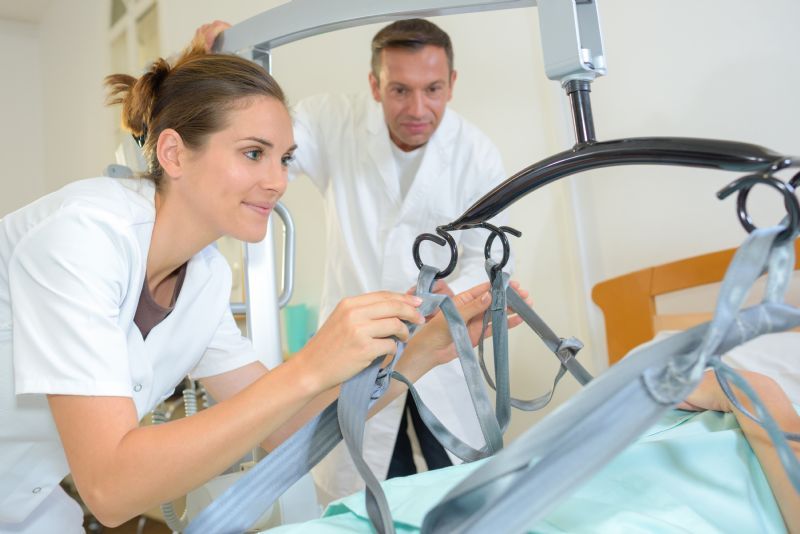
For transfers on and off a chair, bed, tub, wheelchair, or other seat, a patient lift is called for when the person to be transferred is completely immobile. A patient transfer aid is used when a person has some weight-bearing ability.
Most transfers are going to include at least one of the following: sliding, stand-pivot, stand-step, and bent-pivot. The goal is to get the patient transferred in a manner that is safe for the patient and the caregiver. Injuries due to lack of preparation, a sudden change in the level of patient alertness, not using correct body mechanics, a patient’s fear of falling, slippery floors, and even the wrong shoes for the job are not uncommon.
So choosing the proper equipment and being prepared ahead of time are the first steps to staging a safe and successful patient transfer. Having everything necessary within arm’s reach and ensuring the path is clear, the way is well-lit and the floors are not slippery will go a long way toward a smooth transfer.
Demonstrating the action for the patient and giving clear and concise instructions will help the patient feel more comfortable, confident, and calm. It’s a good idea to allow the patient to remain in a new position for a few seconds to facilitate blood pressure stabilization. If it’s possible, patients should move toward their strongest side.
A patient transfer device like a sit-to-stand lift can move the patient from a sitting to a standing position, roll them to another seat, and then safely help them lower themselves to a seated position. This is also useful in getting into and out of a car.
Wet floors in a small space are the cause of many preventable falls in the bathroom. For caregivers attempting to make a patient transfer in a bathroom, it can be a risky proposition for them and their patients. The patient fall risk and caregiver injury risk can be decreased significantly by following prescribed safety measures, which include using proper procedures with appropriate patient lifts.
Shower-commode chairs help people safely bathe and use the toilet, and these devices can also act as transport devices. With the help of a caregiver, some patients can directly transfer from a chair or bed to a shower-commode chair. Patients with weight-bearing ability will benefit from a sit-to-stand transfer aid to get up from a seat and down onto the shower-commode chair.
Water and corrosion-resistant, these shower-commode chairs are easy to maintain and will last for years. Most of these devices are versatile and can be used as bedside commodes, shower chairs, and over-toilet assistive devices. They make personal patient care like bathing and toileting easier and safer for patients and caregivers.
Transfer sheets and transfer boards help caregivers safely move, reposition, and transfer immobile patients and partially immobile patients. Transfer sheets are used with the patient lying horizontally either face up or face down. Transfer boards are used with the patient in a seated position. Seat-to-seat transfers, like from a car to a wheelchair, can also be accomplished with transfer boards.
Transfer sheets make moving patients in bed easier. Sometimes they are made of slick fabric to facilitate sliding the patient up in bed.
Modern transfer boards are constructed from rigid plastics that make them lightweight, flexible, and strong. They are used to slide a seated patient from one location to another.
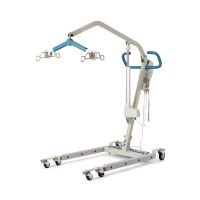 | Medline Electric Hoyer Lift - Adjustable Base and 6-Point Cradle View Product |
Entering our list at number 5 is the Electric Hoyer Lift by Medline. This patient lift boasts a power-adjustable base that caters to patients of all sizes. With just a simple touch of a button, you can easily maneuver the lift to accommodate patients and wheelchairs with absolute ease. No more straining or struggling, this lift does all the heavy lifting for you! The Electric Hoyer Lift features a six-point cradle that ensures optimal weight distribution and stability. This means you can confidently use a variety of slings for different patient needs, providing ultimate comfort and support.
With a 700-pound limit, you can trust that our lift can handle even the heaviest of patients. Plus, with the inclusion of gait training arms, you can help patients regain their mobility and independence, making their recovery journey a breeze.
We particularly love the optional off-board charging station for ease of use and convenience. This allows you to have a fully charged battery at your fingertips at all times, ensuring uninterrupted use of the lift.
The Medline Electric Hoyer Lift with Power-Adjustable Base makes it onto the 5th spot on our list due to its user-friendly controls, impressive lifting height, and unmatched durability, this lift is a game-changer for caregivers and patients alike.
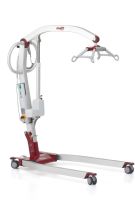 | Molift Smart 150 Lightweight Portable Patient Lift View Product |
The number 4 patient transfer device on our list is The Molift Smart 150 Patient Lift because it is a versatile and compact lift that excels in performing patient movement and transfer tasks within confined spaces. Its generous lifting height simplifies various lifting tasks, including lifting from the floor.
Featuring a standard four-point sling bar, this patient lift is designed for use with a wide range of patient slings from Molift, ensuring optimal safety, comfort, and longevity. Its portability and foldable design enhance user convenience. The lift's wide lifting range facilitates lifting from the floor, and the combination of the standard four-point sling bar with a Molift sling ensures comfortable and correct positioning during transfers.
For ease of transportation, the Molift Smart 150 Patient Lift can be divided into two parts or folded and unfolded without the need for tools. Each section weighs 28 pounds, and the manually adjustable legs enhance accessibility. When folded, the lift can be conveniently stored under beds, in closets, or in a travel case for traveling purposes.
Notable features of this lift include an automatic service notification, electric and manual lowering functions, and an emergency stop feature. Multiple lifting speeds ensure a smooth and gentle lift, providing reassurance and greater comfort to the patient. Additionally, an electronic inbuilt lifting counter allows users to monitor lifting patterns, aiding in diagnostics during service and inspection times. Each lift comes with a power pack battery system, battery charger, hand control, operator manual, and instructional DVD.
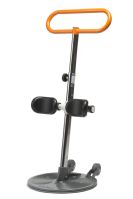 | Etac Turner PRO Sit-to-Stand Patient Transfer Turning Aid View Product |
The number 3 item on our is The Turner PRO Sit-to-Stand Patient Transfer Turning Aid by Etac because it offers support for patient transfers between seated positions and ensures ergonomic positioning for the caregiver. It can be moved easily as it's highly portable and has casters that can turn in 360 degrees. The turner is designed for patients with full leg mobility, verbal communication abilities, and no behavioral issues.
This compact turn aid facilitates the comfortable and safe movement of patients, minimizing the risk of injuries for both the caregiver and the patient. The bright orange handle serves as a focal point for visually impaired or dementia patients, reducing uncertainty and insecurity for both the patient and caregiver. It enables eye contact and communication during transfers, easing stress and promoting comfort. The handle allows for various grip options during standing and movement, ensuring a secure and comfortable transfer.
The smaller footplate design allows the turner to be used in confined spaces. Its cast aluminum base and integrated anti-slip function ensure durability and safety. Adjustable height-angled leg support provides lateral patient support, allowing for easy position adjustments.
The turner's design minimizes the risk of caregiver injury. Adjustable handle height prevents unnecessary strain on the caregiver and enables them to counter-balance the user's weight. Weighing only 16.5 lbs and featuring a compact size, the Etac Turner PRO is lightweight, convenient to transport, and easy to store.
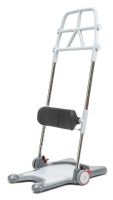 | Molift Raiser Pro Sit-to-Stand Patient Lift View Product |
The Molift Raiser Pro Sit-to-Stand Patient Lift by Molift comes in at number 2 on our list. It provides some independence and allows patients to participate in the transfer process by using their own muscles while remaining safe during transfers.
Its “stand transfer platform” sets this patient lift apart. After the patient steps onto the non-skid platform and is safely in a standing position, the caregiver rolls the platform to the next seat, whether that be a toilet, a bed, or a chair.
This sit-to-stand lift has additional support options. A pair of soft handles that attach to the handrails provide the patient with extra inches to reach independently to pull up to a standing position. Optional strap belts are great for moving patients over longer distances. The Raiser Safety Strap secures the patient around the back, hips, or upper thighs while the patient is standing. The Safety Strap with Sliding Function is placed under the patient with one side latched to the main patient lift and the other pulled by the caregiver to move the patient to a standing position. The Raiser Belt is similar but has an adjustable buckling belt for added safety. The straps come in small, medium, large, and x-large sizes.
It has four small casters that lock with a one-foot touch. They make it highly maneuverable in small spaces and it has a workload of 375 pounds.
This sit-to-stand lift utilizes a patient’s ability, strength, and balance to participate in the transfer process. It landed a spot on our list because of its unique transfer platform and the design that makes adjusting and securing the patient so easy for the caregiver. Its size and maneuverability make it ideal for cramped spaces, even bathrooms. The height-adjustable padded leg support is controlled with one hand, and by locking one wheel with a foot brake, the mechanism secures both casters. It comes in a variety of sizes and safety strap configurations. If you want a simple-to-use sit-to-stand lift with lots of options, this quality-built piece will serve you well for years to come.
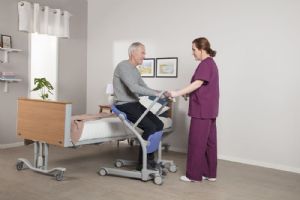 | Sara Stedy Patient Transfer Aid by ArjoHuntleigh (FULLY ASSEMBLED) View Product |
Landing our #1 spot on our list of top patient transfer devices is the Sara Stedy Patient Transfer Aid from ArjoHuntleigh. The versatility of this manual patient lift lies in its ability to serve patients with varying degrees of mobility, ability, and strength. In addition to being a patient transfer device, it can be used for therapeutic exercises.
The two twist-away ergonomically curved seat panels each swing out of the way so the patient can get on and off the standing platform. Once the patient is standing, the panels are easily grasped by the caregiver to return the seat panels to their position, which allows the patient to sit at an angle. The patient can use the convenient crossbar as a support to self-raise or lower from sitting and standing.
Its low clearance chassis with adjustable width allows the base to slide under low beds and wide furniture such as wheelchairs. The curved handles are comfortable for caregivers and the wheel locks are simple to operate.
This manual patient lift has no electrical components so it’s always ready for use and can accommodate patients up to 400 pounds. As a therapy tool, it can help users develop or recover the strength and coordination necessary to stand and sit without a lift. Using its knee panel and crossbar handle, patients can practice raising and lowering themselves.
This simply and intuitively designed patient transfer device made our list for several reasons. It can be operated by a single caregiver and the easy-to-use foot controls for base width adjustment and wheel locking keep the transfer process controlled and safe. With no electrical parts, there is no need for a battery or to be positioned near a power source. The added versatility as a therapy device and its ability to handle patients weighing up to 400 pounds make this patient lift one of our top choices.
Patient lift aids reduce the risk of injury to caregivers, require fewer caregivers on hand, and provide safe access to multiple areas of a home while protecting caregiver health. The ability to transfer at will in a manner that is safe and efficient adds to a patient’s quality of life and makes the job of caregiving significantly easier.
Our list of patient lifting devices for home use supports aging in place even when mobility becomes a serious issue. Caregivers can rely on this equipment to bear the weight during patient transport and the patient can safely and comfortably be moved from one place to another in their own home. Stuck between choosing the right transfer device? Read our article How to Choose the Best Patient Transfer Device!
For more information about caregiving support and to learn more about helpful tools for the job of living, check out our comprehensive resource, Caregiver University.

Co-Founder of Rehabmart and an Occupational Therapist since 1993. Mike has spent his professional career working in multiple areas of Occupational Therapy, including pediatrics, geriatrics, hand therapy, ergonomics and inpatient / outpatient rehabilitation. Mike enjoys writing articles that help people solve complex therapeutic problems and make better product choices.